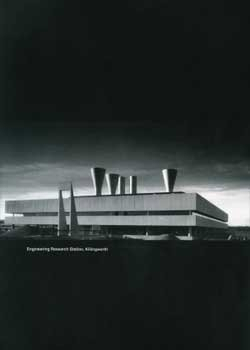
Ryder & Yates, Pair's Design Still Force for Good
04 06, 09 Topic: Ryder & Yates

Newcastle Journal Live
THE architect Peter Yates once began a lecture with the quote that a city should be “for the convenience of its inhabitants and a surprise to its visitors”.
Well, the Tyneside architectural practice of Peter Yates and Gordon Ryder certainly sprang a few surprises over 30 years from the formation of the partnership in 1953.
Their modernist style produced projects such as the 1965 Norgas House, the first major building in Killingworth New Town in North Tyneside.Two years later they followed up with the award-winning and now listed Engineering Research Station, also in Killingworth, which was later used as offices by North Tyneside Council.
Among Ryder and Yates buildings in Newcastle are MEA House, studios 1 and 5 at the former Tyne Tees TV in City Road, the nearby Salvation Army Men’s Palace overlooking the Tyne and the Vickers factory on Scotswood Road.
The importance of Ryder and Yates has now been recognised by a new book in a series on 20th Century architects by Riba Publishing, English Heritage and the Twentieth Century Society.
Not only is it the first book in the series, but Ryder and Yates is the only practice outside London to be featured.
The author of the book, Ryder and Yates (£20), is architect Rutter Carroll, who lives in Gosforth in Newcastle.
He describes the work of Ryder and Yates as “regional, but also national and even international in the scope of its ideas and in its calibre”.
Peter Buchan is chief executive of Ryder Architecture, which grew out of Ryder and Yates, and has designed the £24m Newcastle City Library which opens to the pubic on Sunday.
He says of the work of Ryder, Yates and colleague Ted Nicklin: “Their passion and unswerving dedication to architecture as a force for good in the world continues to inspire the profession today. It infused every aspect of their lives. The ERS building in Killingworth looks timeless and beautiful. It’s a fantastic piece of integrated architecture.” Rutter says: “They produced a great body of work and it has stood the test of time.”
The partnership began in an office near the Hancock Museum in Newcastle and then moved to Jesmond Road and later to Killingworth.
“It has been suggested that the practice would have gained far more recognition and commissions had it moved to London. But this was never considered,” says Rutter.
“Both partners loved the North East and felt it the ideal place to bring up their families.
“The proximity of the North Sea meant that Gordon Ryder could indulge his passion for sailing , while Peter Yates could paint the Northumbrian countryside that he loved.”
The thrust of modernist architecture to create a brave new world after the Second World War has long been controversial.
Tower blocks, seas of concrete and system building produced a backlash from people who felt it was cutting brutal swathes through towns and cities.
Peter Buchan acknowledges that mistakes were made in the 1950s, 60s and 70s in the push to sweep aside the past for the new.
But he says: “Let’s not chuck the baby out with the bath water.
“I don’t think any generation is able to rationally assess the works of the previous generation. You need the passage of a little bit of time.”
Ryder was a member of Tynemouth Sailing Club and one of his early works in 1951 was their new club house in Prior’s Haven. A clubhouse for Beadnell Sailing Club in Northumberland followed.
The partnership designed a house for builder James Liddell in Grand Parade, Tynemouth. When Mr Liddell wanted to build a tall block of flats on the coast at Whitley Bay, Ryder and Yates produced the 11-storey Beacon House block of 44 luxury flats in 1959 – the first multi-storey residential building in the North East.
Other residences included a house at Stanton Hall, near Morpeth, for Alice Mamourian, who came from a wealthy Northumbrian landowning family.
There were also homes for the Ryders – Trees at Woolsington, on the edge of Newcastle, and Triangles at Riding Mill. In 1962 Newcastle Council commissioned a high profile housing development at North Kenton, with school, pub and shops. Another Ryder and Yates housing development was at Albany Village in Washington.
Commercial work included a Ford garage and showroom for Patterson’s on Scotswood Road and the Amberley office block in Killingworth.
Peter Yates died in 1982, aged 62. Gordon Ryder passed away in 2000.
Peter Buchan says: “I like to think their spirit lives on in Ryder today.”
<
He describes the work of Ryder and Yates as “regional, but also national and even international in the scope of its ideas and in its calibre”.
Peter Buchan is chief executive of Ryder Architecture, which grew out of Ryder and Yates, and has designed the £24m Newcastle City Library which opens to the pubic on Sunday.
He says of the work of Ryder, Yates and colleague Ted Nicklin: “Their passion and unswerving dedication to architecture as a force for good in the world continues to inspire the profession today. It infused every aspect of their lives. The ERS building in Killingworth looks timeless and beautiful. It’s a fantastic piece of integrated architecture.” Rutter says: “They produced a great body of work and it has stood the test of time.”
The partnership began in an office near the Hancock Museum in Newcastle and then moved to Jesmond Road and later to Killingworth.
“It has been suggested that the practice would have gained far more recognition and commissions had it moved to London. But this was never considered,” says Rutter.
“Both partners loved the North East and felt it the ideal place to bring up their families.
“The proximity of the North Sea meant that Gordon Ryder could indulge his passion for sailing , while Peter Yates could paint the Northumbrian countryside that he loved.”
The thrust of modernist architecture to create a brave new world after the Second World War has long been controversial.
Tower blocks, seas of concrete and system building produced a backlash from people who felt it was cutting brutal swathes through towns and cities.
Peter Buchan acknowledges that mistakes were made in the 1950s, 60s and 70s in the push to sweep aside the past for the new.
But he says: “Let’s not chuck the baby out with the bath water.
“I don’t think any generation is able to rationally assess the works of the previous generation. You need the passage of a little bit of time.”
Ryder was a member of Tynemouth Sailing Club and one of his early works in 1951 was their new club house in Prior’s Haven. A clubhouse for Beadnell Sailing Club in Northumberland followed.
The partnership designed a house for builder James Liddell in Grand Parade, Tynemouth. When Mr Liddell wanted to build a tall block of flats on the coast at Whitley Bay, Ryder and Yates produced the 11-storey Beacon House block of 44 luxury flats in 1959 – the first multi-storey residential building in the North East.
Other residences included a house at Stanton Hall, near Morpeth, for Alice Mamourian, who came from a wealthy Northumbrian landowning family.
There were also homes for the Ryders – Trees at Woolsington, on the edge of Newcastle, and Triangles at Riding Mill. In 1962 Newcastle Council commissioned a high profile housing development at North Kenton, with school, pub and shops. Another Ryder and Yates housing development was at Albany Village in Washington.
Commercial work included a Ford garage and showroom for Patterson’s on Scotswood Road and the Amberley office block in Killingworth.
Peter Yates died in 1982, aged 62. Gordon Ryder passed away in 2000.
Peter Buchan says: “I like to think their spirit lives on in Ryder today.”
<
